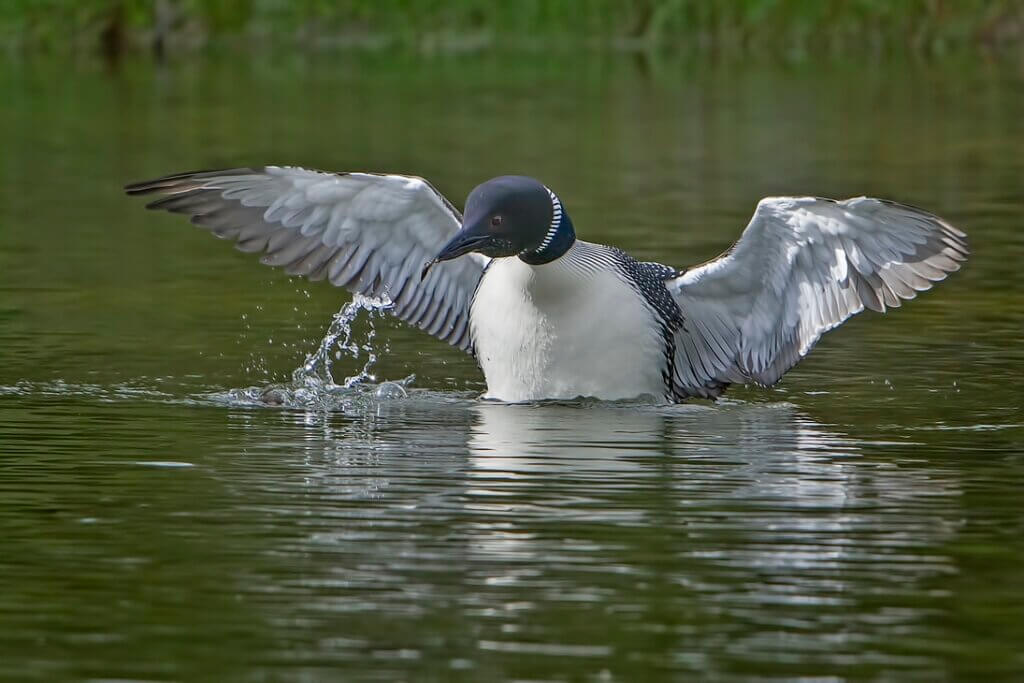The Dancing Loon: A Close Call
By Janet Cass
Broadcast 6.21 & 6.24.2023

Common Loon with chick. Photo by Alan D. Wilson, naturespicsonline.com, CC by-SA 3.0.
Listen:
It’s a beautiful late-June day, perfect for walking around Clearwater Lake in Lolo National Forest. The trail to the lake opens onto a comparatively open area, where Clearwater Lake really is astonishingly clear. Behind it is the Swan Range, and the volunteer guide points out the Swan’s avalanche chutes, which feed the lake.
Circumnavigating the water, we come to a tree on the shore, with a sign on the ground at the base of it. The sign asks people to refrain from fishing in that area because loons are nesting nearby.
Human activity too close to a loon nest will cause the parents to abandon their nest, whether or not eggs or chicks are in it. Even if a loon returns after an hour to sit on eggs, by that time the eggs have cooled so much they’re no longer viable. The paper sign had clearly been attached to the tree but judging by its ripped corner, our hunch is that someone tore it off.
We continue walking, giving the shoreline a wide berth to avoid scaring any loons that might be around. Now we’re on the opposite side of the lake and—we see them. Two adult Common Loons. They’re in an inlet, and it looks as though they’re taking turns going underwater. Oh, they’re lovely: streamlined, low-slung bodies, perfect for diving. Sleek black heads, red eyes, and characteristic black-and-white coloration that makes it easy to identify them.
We watch them, saying little and in hushed voices when we do speak.
Something catches my eye. It’s a white blob in a treetop at the far end of the lake. I can’t see it clearly, but wonder if it could be a Bald Eagle.
My gaze continues back and forth between the blob and the two adult loons, now on the water’s surface, now below it. Probably hunting fish, their primary food.

Common Loon “penguin dancing.” Photo by Alan D. Wilson, naturespicsonline.com, CC by-SA 3.0.
Suddenly, one of the loons looks like it’s standing on top of the water, its wings stretched out wide, flapping. An adult loon’s wingspan is almost five feet, so this bird looks big, much bigger than it did a second ago when it was floating on the water. It’s got to be either a mating display or an aggressive stance.
Doubtful it’s for mating, since this loon looks like it’s paired up with the other one. By default, the loon must be aggressively defending something. Its behavior’s called “penguin dancing” and it’s indeed aggressive, performed to defend a loon’s territory or chicks from other loons, predators, and boats, even quietly paddled ones. And while we may not be close enough to hear the loon vocalizing, it could be yodeling. That’s the call that a male loon makes when defending its territory or when it sees a predator.
Penguin dancing requires a lot of energy. That’s another reason not to fish in loon territory. Whether a person fishes from shore or from a boat, it reduces the loon’s food supply, stresses the loon, and costs the bird energy.
And if it scares away the adults permanently? Chicks die and eggs fail to hatch. According to Montana Fish, Wildlife & Parks, Common Loons are a Species of Concern in Montana, with human disturbance the biggest threat to their survival.
The loon continues penguin dancing, its mate unseen. Maybe the mate is underwater near the dancing loon, maybe it’s back at the nest after swimming there underwater. They can stay submerged for five minutes.
There isn’t an obvious threat to the loon in this peaceful place. None that we can see. Our small group of hikers hasn’t moved. We’ve been in full view of the loons for a while now, quietly watching.
Suddenly—an eagle streaks past. Right in front of us! It’s flying low, toward the inlet where the loons are. The dancing loon vanishes. The eagle gains altitude and we lose sight of it. Maybe it’s perched in a lakeside tree, waiting for another chance.
The white blob in the top of the tree at the far end of the lake isn’t there anymore. The inlet is quiet. If we were just now arriving at this spot it would seem serene.
The adult loons survived. This time.
Every week since 1991, Field Notes has inquired about Montana’s natural history. Field Notes are written by naturalists, students, and listeners about the puzzle-tree bark, eagle talons, woolly aphids, and giant puffballs of Western, Central and Southwestern Montana and aired weekly on Montana Public Radio.
Click here to read and listen to more Field Notes. Field Notes is available as a podcast! Subscribe on Apple Podcasts or wherever you listen to podcasts.
Interested in writing a Field Note? Contact Allison De Jong, Field Notes editor, at adejong [at] montananaturalist [dot] org or 406.327.0405.
Want to learn more about our programs as well as fun natural history facts and seasonal phenology? Sign up for our e-newsletter! You can also become a member and get discounts on our programs as well as free reciprocal admission to 300+ science centers in North America!












